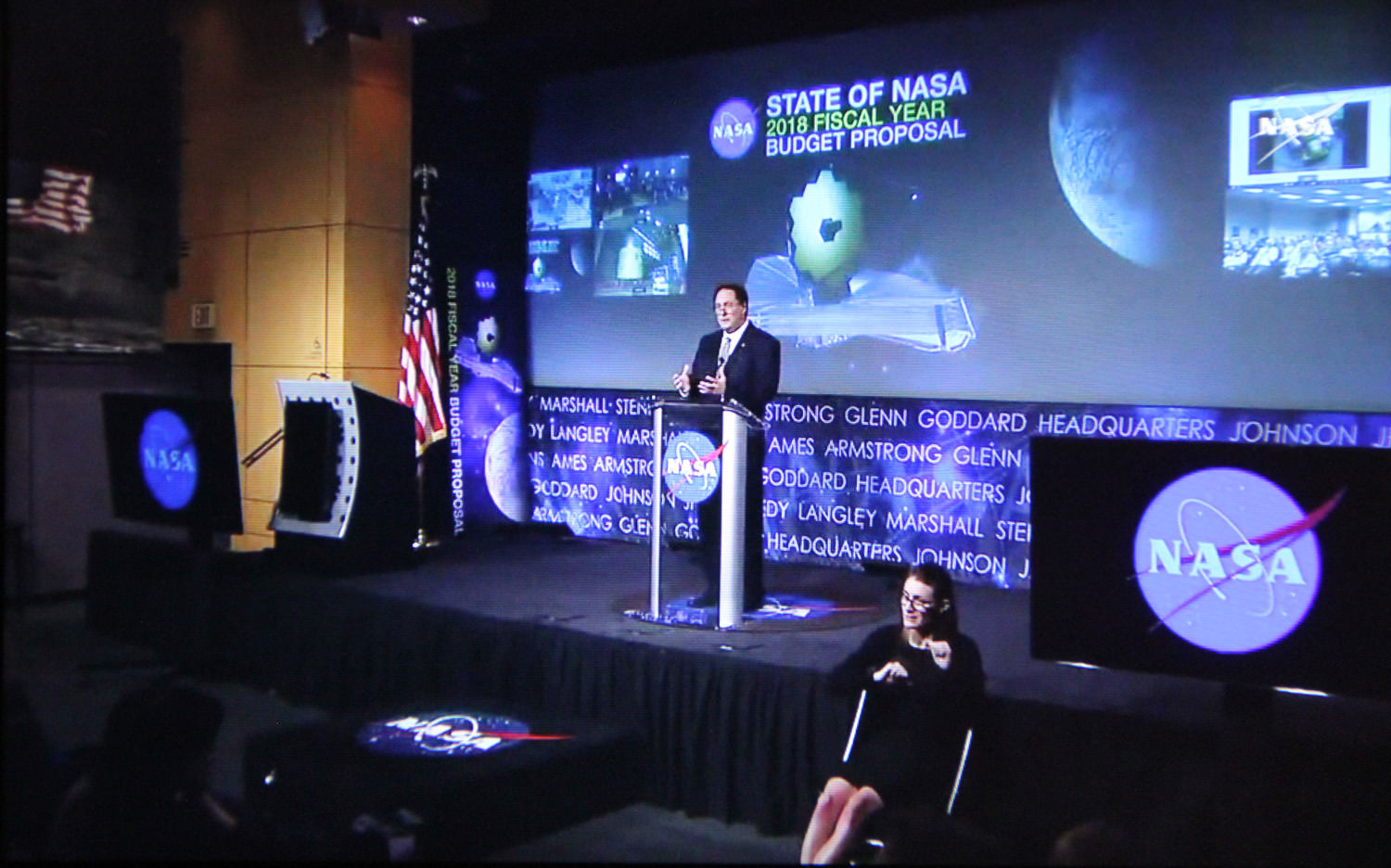
NASA acting administrator Robert Lightfoot outlines NASA's Fiscal Year 2018 budget proposal during a 'State of NASA' speech to agency employees held at NASA HQ on May 23, 2017. Credit: NASA TV/Ken Kremer
The Trump Administration has proposed a $19.1 Billion NASA budget request for Fiscal Year 2018, which amounts to a $0.5 Billion reduction compared to the recently enacted FY 2017 NASA Budget. Although it maintains many programs, the budget also specifies significant cuts and terminations to NASA's Earth Science and manned Asteroid redirect mission as well as the complete elimination of the Education Office.
Overall NASA's FY 2018 budget is cut approximately 3%, or $560 million, for the upcoming fiscal year starting in October 2017 as part of the Trump Administration's US Federal Budget proposal rolled out on May 23, and quite similar to the initial outline released in March.
The cuts to NASA are smaller compared to other Federal science agencies also absolutely vital to the health of US scientific research - such as the NIH, the NSF, the EPA, DOE and NIST which suffer unconscionable double digit slashes of 10 to 20% or more.
The highlights of NASA's FY 2018 Budget were announced by NASA acting administrator Robert Lightfoot during a 'State of NASA' speech to agency employees held at NASA HQ, Washington, D.C. and broadcast to the public live on NASA TV.
Lightfoot's message to NASA and space enthusiasts was upbeat overall.
"My basic message is 'keep going!'" NASA acting administrator Robert Lightfoot said.
"Keep doing what we've been doing. It's very important for us to maintain that course and move forward as an agency with all the great things we're doing."
"I want to reiterate how proud I am of all of you for your hard work – which is making a real difference around the world. NASA is leading the world in space exploration, and that is only possible through all of your efforts, every day."
"We're pleased by our top line number of $19.1 billion, which reflects the President's confidence in our direction and the importance of everything we've been achieving."
Lightfoot recalled the recent White House phone call from President Trump to NASA astronaut & ISS Station Commander Peggy Whitson marking her record breaking flight for the longest cumulative time in space by an American astronaut.
Lightfoot further recounted the outstanding scientific accomplishments of NASA's Mars rover and orbiters paving the path for the agencies plans to send humans on a 'Journey to Mars' in the 2030s.
"We've had a horizon goal for some time now of reaching Mars, and this budget sustains that work and also provides the resources to keep exploring our solar system and look beyond it."
Lightfoot also pointed to upcoming near term science missions- highlighting a pair of Mars landers - InSIGHT launching next year as well as the Mars 2020 rover. Also NASA's next great astronomical observatory - the James Webb Space Telescope (JWST).
"In science, this budget supports approximately 100 missions: 40 missions currently preparing for launch & 60 operating missions."
"The James Webb Space Telescope is built!" Lightfoot gleefully announced.
"It's done testing at Goddard and now has moved to Johnson for tests to simulate the vacuum of space."
"SLS and Orion are far beyond concepts, and as I mentioned, components are being tested in multiple ways right now as we move toward the first flight of that integrated system."
NASA is currently targeting the first integrated launch of SLS and Orion on the uncrewed Exploration Mission-1 (EM-1) for sometime in 2019.
Top NASA managers recently decided against adding a crew of two astronauts to the flight.
NASA would have needed an additional $600 to $900 to upgrade EM-1 with humans.
Unfortunately Trump's FY 2018 NASA budget call for a slight reduction in development for both SLS and Orion - thus making a crewed EM-1 flight fiscally unviable.
The budget request does maintain full funding for both of NASA's commercial crew vehicles planned to launch astronauts to the ISS from US soil on US rockets - namely the crewed Dragon and CST-100 Starliner - currently under development by SpaceX and Boeing.
No comments:
Post a Comment